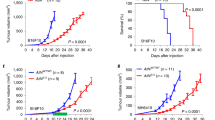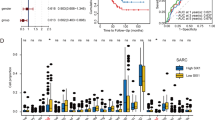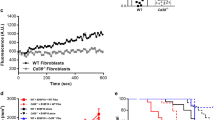Abstract
Tumor cells, stromal cell compartment and the extracellular matrix (ECM) together generate a multifaceted tumor microenvironment. Matrix metalloproteinases and their tissue inhibitors (TIMPs) provide a means for tumor–stromal interaction during tumorigenesis. Among TIMPs, TIMP-3 is uniquely localized to the ECM and is frequently silenced in human cancers. Here, we asked whether the absence of TIMP-3 in the tumor cell or the host affects the process of tumorigenesis. Timp-3−/− ES-cell clones were generated and used to develop teratomas in nude mice. Timp-3−/− teratomas showed similar tumor take, growth, and angiogenesis compared to timp-3+/+ teratomas. To study the effect of TIMP-3 ablation in the host stroma, we measured the growth kinetics of subcutaneous B16F10 melanomas in timp-3−/− and wild-type littermates. Tumors grew significantly faster in timp-3−/− than in wild-type mice and their CD31 content was significantly higher indicating increased angiogenesis. Augmented angiogenesis in timp-3−/− mice was directly tested using Matrigel plug and Gelfoam assays. In response to FGF-2, timp-3−/− endothelial cells invaded more efficiently, leading to enhanced formation of functional blood vessels. Thus, TIMP-3 deficiency in the host, but not in the tumor per se, leads to enhanced tumor growth and angiogenesis. TIMP-3 located within the tumor microenvironment inhibits tumorigenesis.
This is a preview of subscription content, access via your institution
Access options
Subscribe to this journal
Receive 50 print issues and online access
$259.00 per year
only $5.18 per issue
Buy this article
- Purchase on Springer Link
- Instant access to full article PDF
Prices may be subject to local taxes which are calculated during checkout



Similar content being viewed by others
References
Anand-Apte B, Bao L, Smith R, Iwata K, Olsen BR, Zetter B et al. (1996). Biochem Cell Biol 74: 853–862.
Anand-Apte B, Pepper MS, Voest E, Montesano R, Olsen B, Murphy G et al. (1997). Invest Ophthalmol Vis Sci 38: 817–823.
Andreu T, Beckers T, Thoenes E, Hilgard P, von Melchner H . (1998). J Biol Chem 273: 13848–13854.
Bachman KE, Herman JG, Corn PG, Merlo A, Costello JF, Cavenee WK et al. (1999). Cancer Res 59: 798–802.
Bian J, Wang Y, Smith M . (1996). Carcinogenesis 17: 1805–1811.
Boulay A, Masson R, Chenard MP, El Fahime M, Cassard L, Bellocq JP et al. (2001). Cancer Res 61: 2189–2193.
Brooks PC, Stromblad S, Sanders LC, von Schalscha TL, Aimes RT, Stetler-Stevenson WG et al. (1996). Cell 85: 683–963.
Chan VT, Zhang DN, Nagaravapu U, Hultquist K, Romero LI, Herron GS . (1998). J Invest Dermatol 111: 1153–1159.
Coussens LM, Fingleton B, Matrisian LM . (2002). Science 295: 2387–2392.
DeClerck YA . (2000). Eur J Cancer 36: 1258–1268.
Dulaimi E, Ibanez de Caceres I, Uzzo RG, Al-Saleem T, Greenberg RE, Polascik TJ et al. (2004). Clin Cancer Res 10: 3972–3979.
Fata JE, Leco KJ, Voura EB, Yu HY, Waterhouse P, Murphy G et al. (2001). J Clin Invest 108: 831–841.
Folkman J . (2002). Semin Oncol 29: 15–18.
Itoh T, Tanioka M, Yoshida H, Yoshioka T, Nishimoto H, Itohara S . (1998). Cancer Res 58: 1048–1051.
Kassiri Z, Oudit G Y, Sanchez O, Dawood F, Mohammed FF, Nuttall RK et al. (2005). Circ Res 97: 380–390.
Kato T, Kure T, Chang JH, Gabison EE, Itoh T, Itohara S et al. (2001). FEBS Lett 508: 187–190.
Kleiner DE, Stetler-Stevenson WG . (1999). Cancer Chemother Pharmacol 43 (Suppl): S42–S51.
Kruger A, Fata JE, Khokha R . (1997). Blood 90: 1993–2000.
Leco KJ, Waterhouse P, Sanchez OH, Gowing KL, Poole AR, Wakeham A et al. (2001). J Clin Invest 108: 817–829.
Leighl NB, Paz-Ares L, Douillard JY, Peschel C, Arnold A, Depierre A et al. (2005). J Clin Oncol 23: 2831–2839.
Loging WT, Reisman D . (1999). Oncogene 18: 7608–7615.
Lynch CC, Matrisian LM . (2002). Differentiation 70: 561–573.
Martin DC, Ruther U, Sanchez-Sweatman OH, Orr FW, Khokha R . (1996). Oncogene 13: 569–576.
Masson V, de la Ballina LR, Munaut C, Wielockx B, Jost M, Maillard C et al. (2005). FASEB J 19: 234–236.
McCarty MF, Baker CH, Bucana CD, Fidler IJ . (2002). Int J Oncol 21: 5–10.
Michael M, Babic B, Khokha R, Tsao M, Ho J, Pintilie M et al. (1999). J Clin Oncol 17: 1802–1808.
Mori M, Mimori K, Sadanaga N, Inoue H, Tanaka Y, Mafune K et al. (2000). Int J Cancer 88: 575–578.
Murphy G, Knauper V, Lee MH, Amour A, Worley JR, Hutton M et al. (2003). Biochem Soc Symp 70: 65–80.
O'Reilly MS, Holmgren L, Shing Y, Chen C, Rosenthal RA, Moses M et al. (1994). Cell 79: 315–328.
Passaniti A, Taylor RM, Pili R, Guo Y, Long PV, Haney JA et al. (1992). Lab Invest 67: 519–528.
Qi JH, Ebrahem Q, Moore N, Murphy G, Claesson-Welsh L, Bond M et al. (2003). Nat Med 9: 407–415.
Remacle A, McCarthy K, Noel A, Maguire T, McDermott E, O'Higgins N et al. (2000). Int J Cancer 89: 118–121.
Sang QX . (1998). Cell Res 8: 171–177.
Sato H, Takino T, Okada Y, Cao J, Shinagawa A, Yamamoto E et al. (1994). Nature 370: 61–65.
Sogawa K, Kondo K, Fujino H, Takahashi Y, Miyoshi T, Sakiyama S et al. (2003). Cancer 98: 1822–1829.
Soloway PD, Alexander CM, Werb Z, Jaenisch R . (1996). Oncogene 13: 2307–2314.
Spurbeck WW, Ng CY, Strom T, Vanin E, Davidoff A . (2002). Blood 100: 3361–3368.
Spurbeck WW, Ng CY, Vanin EF, Davidoff AM . (2003). Cancer Gene Ther 10: 161–167.
Sternlicht MD, Werb Z . (2001). Annu Rev Cell Dev Biol 17: 463–516.
Sun Y, Hegamyer G, Kim H, Sithanandam K, Li H, Watts R et al. (1995). J Biol Chem 270: 19312–19319.
Sun Y, Kim H, Parker M, Stetler-Stevenson WG, Colburn NH . (1996). Anticancer Res 16: 1–7.
Thurston G, Baluk P, Hirata A, McDonald DM . (1996). Am J Physiol 271: H2547–H2562.
Wild A, Ramaswamy A, Langer P, Celik I, Fendrich V, Chaloupka B et al. (2003). J Clin Endocrinol Metab 88: 1367–1373.
Yu WH, Yu S, Meng Q, Brew K, Woessner Jr JF . (2000). J Biol Chem 275: 31226–31232.
Acknowledgements
We thank Marco Di Grappa, David Smookler and Katrina Watson for their technical assistance. This research is supported by funding from the Canadian Institutes of Health Research to RK.
Author information
Authors and Affiliations
Corresponding author
Rights and permissions
About this article
Cite this article
Cruz-Muñoz, W., Kim, I. & Khokha, R. TIMP-3 deficiency in the host, but not in the tumor, enhances tumor growth and angiogenesis. Oncogene 25, 650–655 (2006). https://doi.org/10.1038/sj.onc.1209104
Received:
Revised:
Accepted:
Published:
Issue Date:
DOI: https://doi.org/10.1038/sj.onc.1209104
Keywords
This article is cited by
-
Disease specific urinary biomarkers in the central nervous system
Scientific Reports (2023)
-
Sorsby Fundus Dystrophy Mutation in Tissue Inhibitor of Metalloproteinase 3 (TIMP3) promotes Choroidal Neovascularization via a Fibroblast Growth Factor-dependent Mechanism
Scientific Reports (2019)
-
Signatures of selection and environmental adaptation across the goat genome post-domestication
Genetics Selection Evolution (2018)
-
TIMPs: versatile extracellular regulators in cancer
Nature Reviews Cancer (2017)
-
Altered Bone Mechanics, Architecture and Composition in the Skeleton of TIMP-3-Deficient Mice
Calcified Tissue International (2017)



